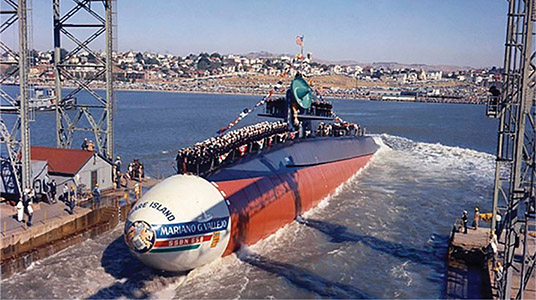In last month's edition of Bay Crossings, I began telling the history of Mare Island and the U.S. Naval Shipyard that used the island for 142 years.

The USS Mariano G. Vallejo (SSBN-658), built at Mare Island Naval Shipyard, was launched on October 23, 1965. Photo courtesy of Mare Island Museum
By Captain Ray
Published: August, 2015
In last month’s edition of Bay Crossings, I began telling the history of Mare Island and the U.S. Naval Shipyard that used the island for 142 years. This month I will complete this fascinating tale.
Mare Island served military needs throughout its time as a naval base. In the 1860s a naval hospital was constructed on the island. From a small 30-bed ward in a converted granary, it grew into a facility with almost 600 beds. This hospital gained worldwide recognition for its work in prosthetics for veterans.
Because the German army made very effective use of U-boats during World War I, in the early 1920s the Navy opened a second west coast submarine facility (the first was on Puget Sound) at Mare Island. Starting with the launch of the USS Nautilus (not the nuclear-powered one) in 1927, this facility went on to build more than 25 diesel/electric submarines, four submarine tenders, and, with the coming of the Atomic Age, 17 nuclear submarines. The Navy ceased construction of submarines at Mare Island in 1972.
The Navy also sometimes shared Mare Island with other branches of the armed forces: The U.S. Marine Corps used it as a recruit training depot from 1911 until 1923, when the depot was relocated to San Diego in 1923. During the Vietnam War, the Navy used Mare Island and the sloughs to the northwest to train riverboat crews.
Mare Island was also used for other activities. In 1892, the first golf course west of the Mississippi River opened on Mare Island. It was only nine holes then, and for the first 30 years the “greens” were sand. The course was famous (or infamous) for an unusual obstacle: a horse belonging to a marine lieutenant that was allowed to wander around. This occurred often enough that the course rules allowed a golfer to move a ball (without penalty) that had been blocked by the horse.
In the 1860s, at the urging of Commandant James Alden, ship captains began to bring trees from all over the world to plant on the island. To this day, Mare Island sports a great variety of “exotics” from the eastern United States, as well as from countries of the Pacific such as China, Japan and Australia. The island’s St. Peter’s Chapel, a small brown shingle structure, was dedicated in 1901 and is now on the National Register of Historic Places. Not only is it the west’s oldest non-denominational naval chapel, it contains artistic treasure: The chapel is adorned with 29 stained glass windows, 16 of which are from the Louis Comfort Tiffany Studios of New York City. It is the largest collection of Tiffany stained glass windows west of the Mississippi River.
The end of Mare Island Naval Shipyard’s long history of service to the nation was signaled by the Base Realignment and Closure Commission’s 1963 recommendation to close the shipyard. It was officially closed and returned to the City of Vallejo on April 1, 1996.
The island’s designations as a National Historic Landmark, a State Historical Landmark and its being listed on the National Register of Historic Districts are all honored in Vallejo’s Reuse Plan. Preservation of the shipyard’s historic core, wetland restoration, housing, commercial, retail and entertainment spaces are all part of this plan.
Some of the shipyard’s buildings have been repurposed by other governmental agencies, including a U.S. Forest Service office building, an Army Reserve Center, and a Coast Guard communications facility. Another part of the island has become a Fish and Wildlife Service refuge, and several of the historic Colonial Revival era mansions on Officer’s Row are available for special functions. The City of Vallejo has redeveloped former Navy housing into 600 market-rate condominiums.
The Mare Island Historical Parks Foundation (www.mareislandhpf.org) offers docent-led tours. These tours last several hours and include the mansions of Officers Row and St. Peter’s Chapel, the drydocks along Mare Island Strait and the shipyard museum.
Ray Wichmann, is a US SAILING-certified Ocean Passagemaking Instructor, a US SAILING Master Instructor Trainer, and a member of US SAILING’s National Faculty. He holds a 100-Ton Master’s License, was a charter skipper in Hawai’i for 15 years, and has sailed on both coasts of the United States, in Mexico, the Caribbean and Greece. He is presently employed as the Master Instructor at OCSC Sailing in the Berkeley Marina.

